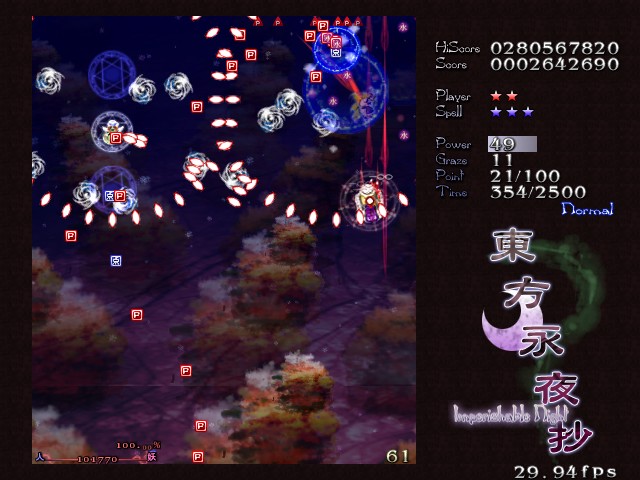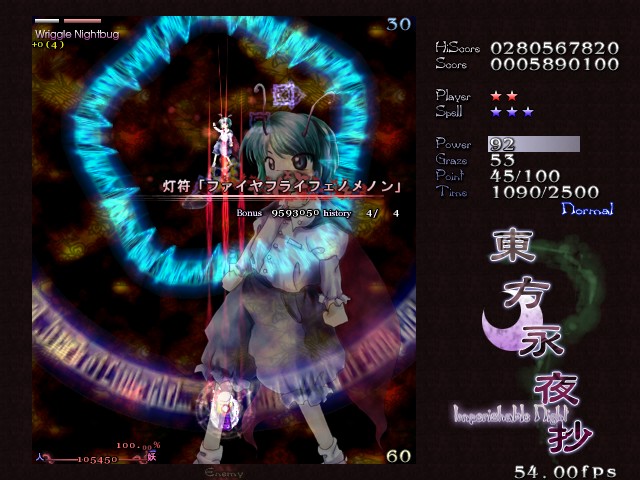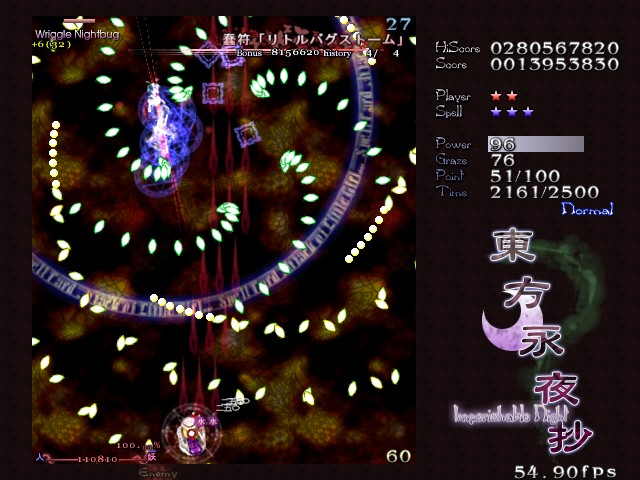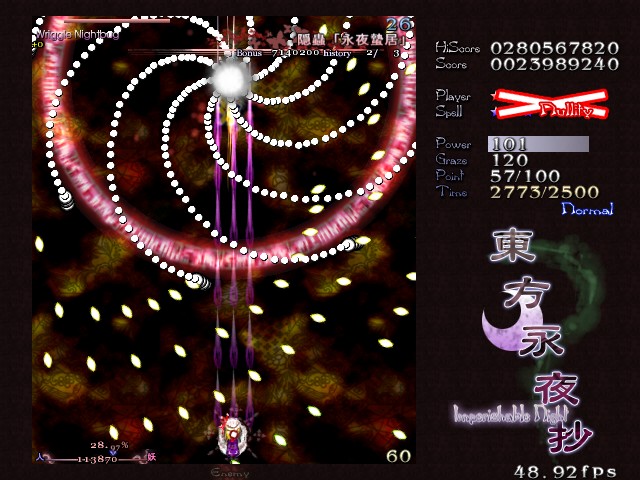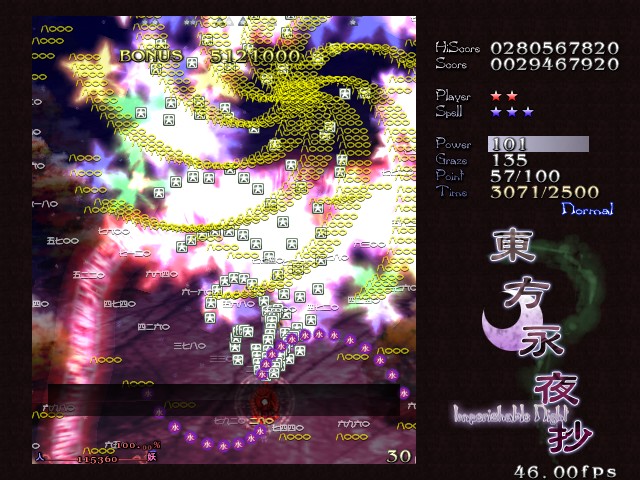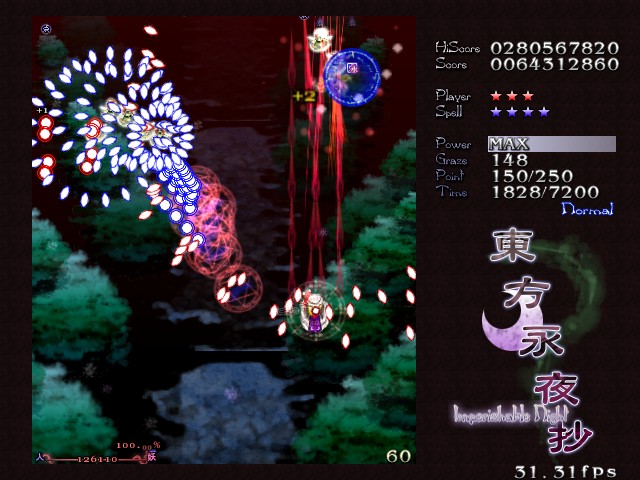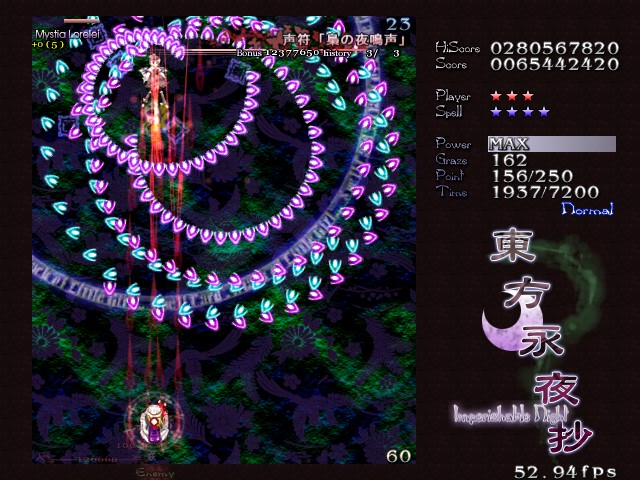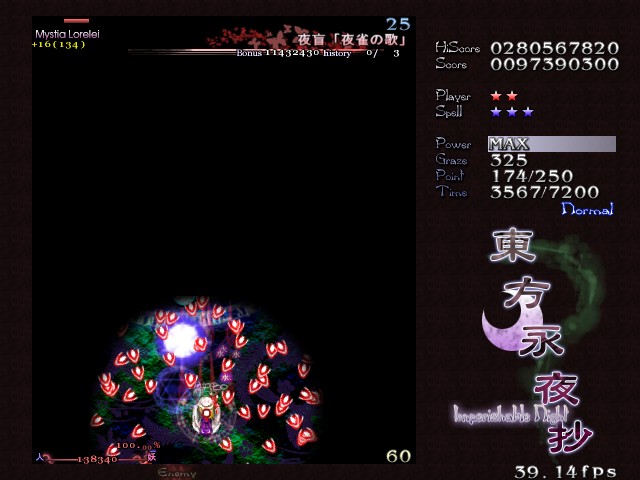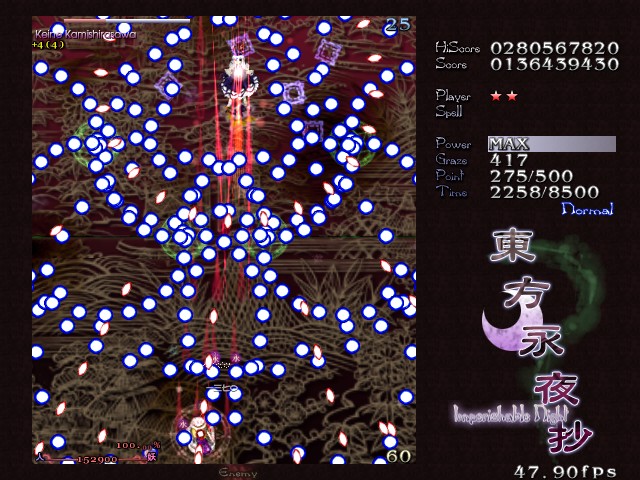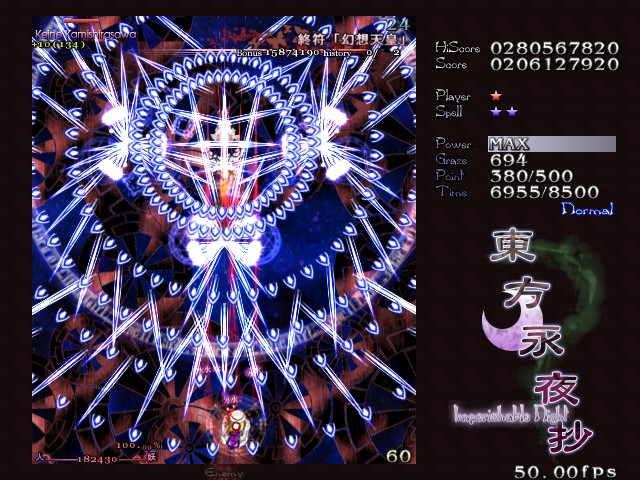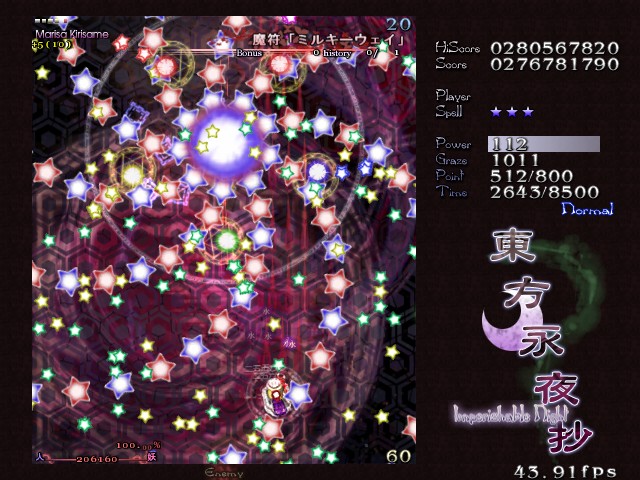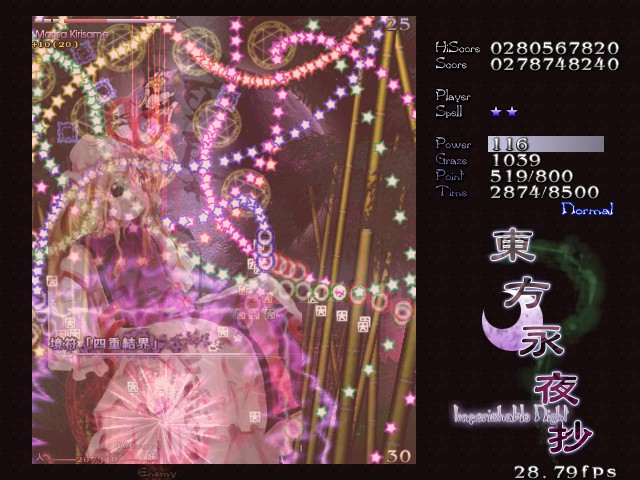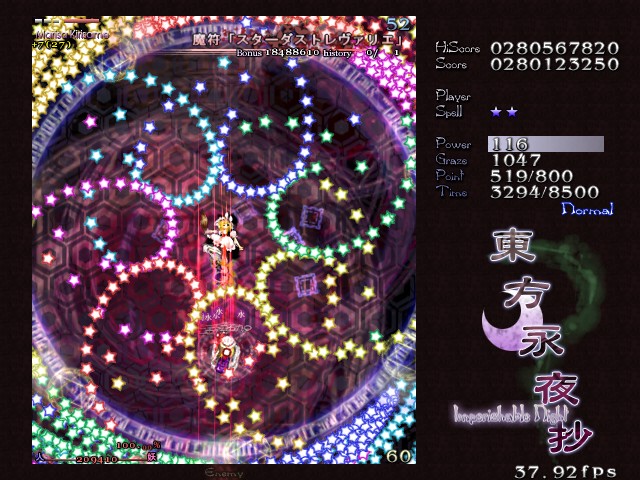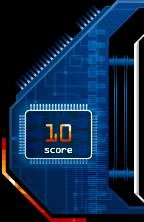Introduction
Imperishable Night is the third in the Shrine Maiden series of shooting games on the PC, created by Team Shanghai Alice (actually just one person, Zun). The previous two installments were Embodiment Of Scarlet Devil which now looks slightly dated in comparison, and Perfect Cherry Blossom which is still extremely impressive now. The games are described as 'Curtain Fire Shooting Games' - I don't know if this is a label picked by the author, or a common Japanese one I haven't seen before, but it certainly fits. The games are laden with bullet patterns, don't involve interaction with the background, and have minimal random or aimed fire. The closest commercial examples I can think of would be the Shikigami games - how does Imperishable Night compare?
Playing the game
Starting the game takes you to the character select screen - where there are four pairs of Shrine Maidens to choose from. Pairs? Each pair has a human and a phantom maiden - the phantom ones all seem to be bosses from previous games in the series which is a nice touch. Yuomu and Yuyuko are a special case, as both girls are phantoms - more on this later. Each maiden in the pair has different attack characteristics, strong against bosses but weak against enemies for example. For a detailed description of their abilities, check out the shrinemaiden.com site linked to at the bottom.
As you play through the game, you'll find the levels are more like a series of staging grounds for powering up (collecting the red 'P' marks) before extended boss encounters. It feels very much like Shikigami No Shiro 2, both in format and supernatural theme, although this is a more defined form of the style, and feels less abstract than Taitos game. You'll quickly start to see larger spreads of fire from the smaller enemies, and phantom mode becomes very useful at this point. In addition to the normal fire and bomb buttons, you have a 'slow' control (which can be set to activate when fire is held down instead). When slow or fire is held, you transform into phantom mode, which changes your attacks and slows the character down considerably. New players may want to stick to using phantom except when absolutely necessary, as it does make navigating larger bullet patterns a lot easier to deal with, although it can be detrimental to your score.
When the main boss encounter for a level starts (sometimes you meet them for a quick battle half way through the level too ), there will be a short intro where the character talks to the boss - of course this is all in Japanese and sadly there's no translation yet that I could find. These are done with hand drawn pictures of the characters fading in and out, with small bits of animation - and they're nicely done.
The battle itself is broken down into sections, bosses will begin to hit you straight away with elaborate bullet patterns, which you can graze (buzz) off for extra points. The bosses have a long life bar with a shorter red section, and will cycle through the same attacks until you've taken them down to the red. At this point, they'll use a spell card, during which the background will change, their attacks will change to much heavier ones, and their defense will increase. If you can beat them during this spell trance without being hit or using a bomb, you'll earn the spell card bonus at the end of their attack - which is worth a lot of points! Once any spell card attacks have been beaten (some bosses have multiple red sections per life bar), if the boss has more life bars in reserve (shown in the top left while playing), the cycle begins again, with harder attacks. The bosses are only beaten when their last spell card is used, and if you've collected a high enough time mark bonus (see below), the boss will cast their Last
Spell, a mode in which you can't bomb and can't die - like a bonus round.
The bullet patterns used by bosses are enormous. You'll see fanning spreads, blistering bulletspitting, direction and speed changes, and layering of all of these. Of course, they can get very hard to avoid even on the standard difficulty, so it's fortunate that you have your own spell cards (bombs) to get you out of trouble - these clear bullets from around you, and damage surrounding enemies, with a nice fading picture effect over the action. If you manage to use a spell card just as a bullet hits you, it will be a Last Spell card, and much more powerful, consuming two of your bomb stock.
In depth gameplay and scoring
The system in Imperishable Night is a complex beast, but luckily zimeon was kind enough to give me an explanation of the gameplay that I couldn't find elsewhere, which is essential for anyone who can't read Japanese but wants to play the game seriously. Skip this section if you just wanted the overview, or read on.
The main scoring bonus in the game, are the blue bonus marks which many enemies leave when killed. The higher up the screen they are collected, the more they're worth - the maximum value being past the point of collection (POC) which varies depending on character (usually near the players lives counter). When doing this, you'll see the item scores turning yellow when you collect. If you're at maximum power or in phantom mode when moving into the POC, you'll absorb all items on the screen at their maximum values. This is where it gets complex, as there's a secondary bonus method which increases this maximum.
Collecting time marks will increase the maximum bonus mark value at the POC by 10 points, and there are several ways to get them. Some enemies (masters) can launch
separately firing familiars (slaves) - these slaves drop time marks when killed, and killing the master results in the master, all slaves, and surrounding bullets being turned into time marks. While in phantom mode, you only see shadows of familiars and can't hit them - so the best way to gain time marks is to let the masters release familiars before switching to phantom mode to kill them.
Your character has a phantom meter, which moves between blue and red depending on your play, from -100% (fully human) to 100% (fully phantom). Shooting and collecting time marks will move your meter more towards human or phantom depending on which mode you're currently in. Not shooting anything, or killing familiars directly will move the meter towards 0%. Past +/- 80% is considered oumagatoki (called 'power' from here onwards) mode. When in human power mode you'll gain time marks just by shooting enemies down, but when in phantom power mode, you can get time marks by grazing boss bullets. This is a good idea, as there's a secondary bonus when defeating spell card attacks, which multiplies your current graze counter by the number of bullets left on screen!
The final way to gain time marks, is defeating boss life bars, as all bullets in their current attack will be converted and collected.
Maximising time spent in power mode is very important, as when you're between -80% and 80%, you only get half the maximum point value at the POC. Getting hit will cost you time marks, an added pressure if you want to maximise score. The best way to keep building up the score, is to stay in human power mode as much as possible to gain the time marks from normal enemy deaths, switch to phantom kill masters and familiars, but quickly revert to human again before the time marks that get dropped are absorbed - pushing you back into the human power mode band. Bosses are best tackled in phantom mode, to maximise the grazing multiplier for beating bosses.
All of the above also varies by character too - Marisa & Alice have a lower POC, Reimu (human) can't be hit by familiars, Sakuya & Remilia get triple graze in power mode, and Yomu & Yuyuko are both phantoms so -30% is their human power mode. There's more than enough to keep technical people very happy here.
Graphics
The graphics in Imperishable Night represent another step forward for the series. The backgrounds are very pretty scrolling polygon ones, with a lot of nice layered effects on them, some of the spell card backgrounds being very good indeed. The character stills from the cut scenes are really nice, and the player and enemy sprites are all small but well drawn. You won't notice any of this however, as the bullets steal the show. The visual spectacle on offer here is breathtaking, I've never seen anything like it. The further you get, the more impressive the patterns become, until they're like multicoloured unfolding flowers - truly amazing. It says a lot that my shmup-apathetic girlfriend actually stopped to watch the game in motion.
Sound
The sound effects are slightly crunchy, but very unobtrusive. You can hear what's going on, but it's not battering your ears with explosions. A nice exception to this is boss charging sounds, which are a deep echo. Also welcome is the sound panning from left to right depending on where the action is. The music is very nice as with the previous two games, containing a mixture of traditional instruments and tunes, now mixed in with some underlying synth work. They're all beautiful and suit the game perfectly, although if I had to pick a fault, the ones in Perfect Cherry Blossom were a little more catchy. Theres the option to have wav audio, or midi. Opinions vary from person to person on this, and it probably depends on your midi soundfont.
Overall
To sum this game up, I would say "small and perfectly formed". In the past I haven't been much of a fan of bullet pattern heavy games, but when they're rendered with such care and attention, it's impossible not to appreciate the results. The same effort has been put into every part of the game, and the end result is a pure, perfectly distilled example of this style of shmup, certainly more on target than the Shikigami games, in my opinion - which feel slightly uncomfortable with themselves and disjointed. There's nothing in the game that doesn't need to be there, and nothing missing either - the ability to save and watch replays being especially nice.
The difficulty level has been well placed too. The default normal is challenging for the average player (after practise, I can reach level 4), but there's an easier option for those who want it, plus hard and the appropriately named 'lunatic' for those who really want to test their abilities.
The only concern (as with all PC games) is as ever, PCs. Ignore the FPS count in the screenshots, I was running it in 32 bit windowed mode, playing back a replay while a screenshot grabber snapped it every few seconds. The equipment used in the review was a Dell Latitude C400, not a very fast machine, with a rubbish Intel graphics chipset, but it ran very well in 16 bit fullscreen mode. As a benchmark, the game does show what percentage of the time your machine couldn't cope along with the score, hitting level 4 showed just over 1% slowdown. This is also a Japanese PC games, and installation does fail if you don't have Japanese unicode support, but if you just copy the directory across from the CD it'll run just fine as the core game files don't use Japanese characters. There is a patch on the website, this patch happily applies without Japanese support too - you just have to fill in the directory to update.
Weigh all this up, consider this is a non commercial game retailing at only $15 made by just one person, that is easily better than many commercial games, and there's only one fair score to award.
10/10






